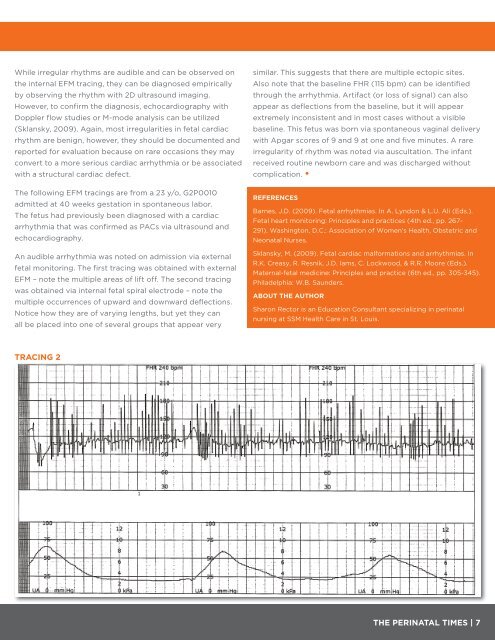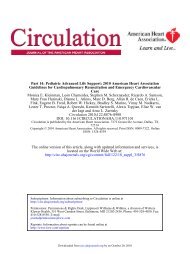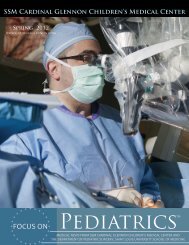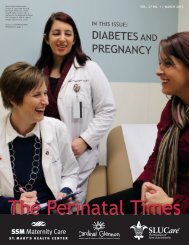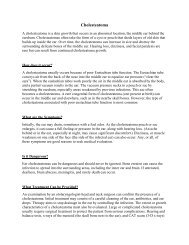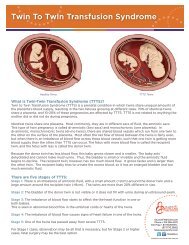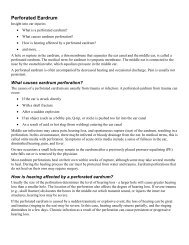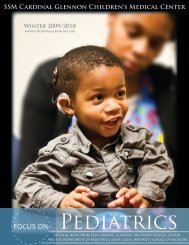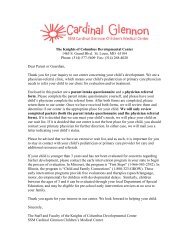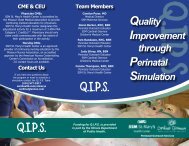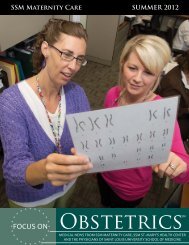print and read version - SSM Cardinal Glennon Children's Medical ...
print and read version - SSM Cardinal Glennon Children's Medical ...
print and read version - SSM Cardinal Glennon Children's Medical ...
- No tags were found...
Create successful ePaper yourself
Turn your PDF publications into a flip-book with our unique Google optimized e-Paper software.
While irregular rhythms are audible <strong>and</strong> can be observed onthe internal EFM tracing, they can be diagnosed empiricallyby observing the rhythm with 2D ultrasound imaging.However, to confirm the diagnosis, echocardiography withDoppler flow studies or M-mode analysis can be utilized(Sklansky, 2009). Again, most irregularities in fetal cardiacrhythm are benign, however, they should be documented <strong>and</strong>reported for evaluation because on rare occasions they mayconvert to a more serious cardiac arrhythmia or be associatedwith a structural cardiac defect.The following EFM tracings are from a 23 y/o, G2P0010admitted at 40 weeks gestation in spontaneous labor.The fetus had previously been diagnosed with a cardiacarrhythmia that was confirmed as PACs via ultrasound <strong>and</strong>echocardiography.An audible arrhythmia was noted on admission via externalfetal monitoring. The first tracing was obtained with externalEFM – note the multiple areas of lift off. The second tracingwas obtained via internal fetal spiral electrode – note themultiple occurrences of upward <strong>and</strong> downward deflections.Notice how they are of varying lengths, but yet they canall be placed into one of several groups that appear verysimilar. This suggests that there are multiple ectopic sites.Also note that the baseline FHR (115 bpm) can be identifiedthrough the arrhythmia. Artifact (or loss of signal) can alsoappear as deflections from the baseline, but it will appearextremely inconsistent <strong>and</strong> in most cases without a visiblebaseline. This fetus was born via spontaneous vaginal deliverywith Apgar scores of 9 <strong>and</strong> 9 at one <strong>and</strong> five minutes. A rareirregularity of rhythm was noted via auscultation. The infantreceived routine newborn care <strong>and</strong> was discharged withoutcomplication. •REFERENCESBarnes, J.D. (2009). Fetal arrhythmias. In A. Lyndon & L.U. Ali (Eds.).Fetal heart monitoring: Principles <strong>and</strong> practices (4th ed., pp. 267-291). Washington, D.C.: Association of Women’s Health, Obstetric <strong>and</strong>Neonatal Nurses.Sklansky, M. (2009). Fetal cardiac malformations <strong>and</strong> arrhythmias. InR.K. Creasy, R. Resnik, J.D. Iams, C. Lockwood, & R.R. Moore (Eds.).Maternal-fetal medicine: Principles <strong>and</strong> practice (6th ed., pp. 305-345).Philadelphia: W.B. Saunders.ABOUT THE AUTHORSharon Rector is an Education Consultant specializing in perinatalnursing at <strong>SSM</strong> Health Care in St. Louis.TRACING 2THE PERINATAL TIMES | 7


